How to Tell What Edition a Book Is
This content contains affiliate links. When you buy through these links, we may earn an chapter commission.
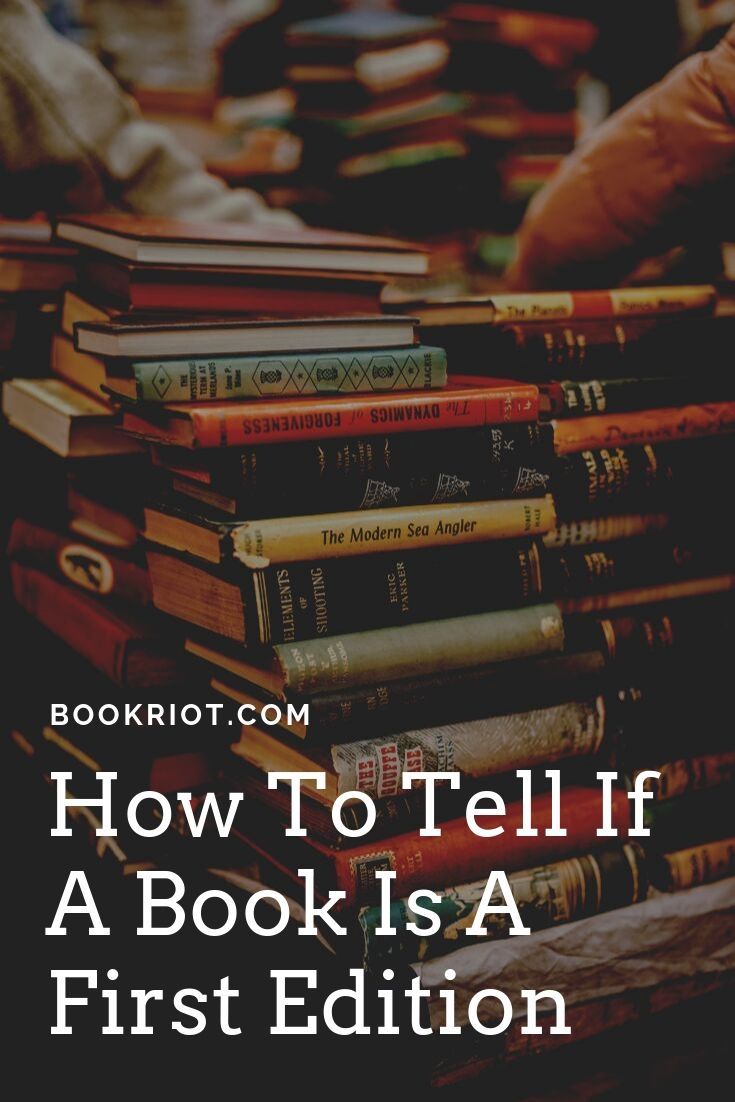
Chances are if you're an avid book collector, you lot've looked at your shelves and idea, "I wonder how valuable some of my books are!" Or perchance you're a used bookstore patron and you've stumbled upon really pristine, really old copies of popular books that were super cheap, and idea mayhap they might be worth more than their sticker price. If you lot don't know how to tell if a book is a first edition, we can help! Go along in heed that but considering you take a commencement edition copy of a certain title doesn't make it inherently valuable—simply if you hold onto it, it might get valuable one twenty-four hour period!

How to Tell if a Book is a First Edition
1. Copyright Engagement
The first thing you want to do is check the copyright date! If the copyright date is the aforementioned as the year the volume was published, so that is a adept first sign!
2. Await for the Words "Get-go Edition" on the Copyright Page
This will fluctuate depending on the publishing business firm, but nigh publishers volition designate that a volume is a first edition on the copyright page. However, but because you see those words doesn't mean you've got a valuable book on your hands! That's considering "beginning edition" means different things to collectors and to publishers. To collectors, it refers to the very get-go version of the physical book to be printed. For publishers, "kickoff edition" may just mean the first version of the text, without meaning revisions. Many publishers volition print the hardcover edition of a book and call that a commencement edition, so print the same text in paperback and call it a first edition as well. Unless the author or publishers makes changes to the text, adds something (like an appendix or author's annotation), or revises the text, there is only i edition from format to format.
3. Look for the Print Run Number
Impress runs are a way for collectors to place which "first edition" is truly the primeval version of the book to exist in the earth. Print runs are the fix number of copies of the book printed at one time. You can have a large print run or a small print run—it's completely up to the publisher, and generally speaking the size of a impress run isn't shared with the public—just the print run number is hands constitute on the copyright page. Information technology is a sequence of numbers, commonly 1–10, and printed in descending or alternating guild. The lowest number found on the page is the print run number.
Speaking by and large, showtime editions will hold the most value if they are first editions, first printings. Depending on who has published the book and what formats it has been published in, you'll be looking for hardcover books by and large. But don't assume all hardcovers are first printings! You lot'll want to take a look at the copyright page, found at the front of nearly books, and look for edition number, date, and impress run number. Every publisher organizes this information differently, and some brand information technology a little disruptive, so yous have to fix to do a little detective piece of work. Let's accept a look at a variety of copyright pages!
Hither's the copyright page for my hardcover copy of Far From the Tree by Robin Benway:
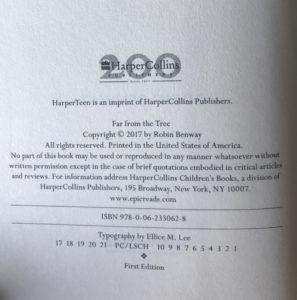
You might observe that at the very bottom, it proclaims "First Edition." Sweet! That means this is the start version of the text published. However, we'll desire to go check the copyright date—and this i says 2017, which is the yr that the showtime hardcover edition was released. Also practiced. Now, to find the print run number, nosotros are going to await beneath the typography credit. Do you see the long list of descending numbers? On the right hand, you accept ten–1. That indicates the impress run numbers. The lowest number y'all tin come across is the print run number, in this instance 1. On the left-mitt side, you see the number 17–21. That refers to the year the print run occurred. Once more, the everyman number you come across is the year information technology was printed—17.
So based off of this data, we can deduce that my re-create of Far From the Tree is a first edition hardcover, first impress fun in the publication twelvemonth 2017. It's the earliest re-create on the market—and considering it was a National Volume Award winner, I'k property on to it as it might one day be worth something!
Only not all publishers format this data in the same mode. Let'due south take a look at my hardcover copy of Story of a Girl by Sara Zarr. It's a hardcover, and in great condition, but it has the National Book Award finalist sticker on it, which makes me think it's not a first print run—the National Book Award books get stickers after they've been out and the honor is announced in November. I opened up my copy, and sure plenty!
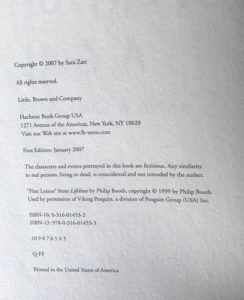
Notice how this copyright page has even less information—it doesn't even accept the title! Just you tin can besides see that it says when the showtime edition was produced: Jan 2007. However, if you await downwardly to the sequence of numbers, the lowest number yous run into is a 3—and then this is the third printing. That tracks—by the third press, the book had probable been named a finalist and was being stickered as it hit shelves.
What about signed outset editions? They can be valuable, only again, edition and print run thing! Here'south my (signed!) copy of Hearts Unbroken past Cynthia Leitich Smith:
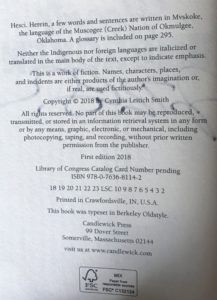
Detect how Candlewick Press has a lot more data on this copyright page than the previous two examples! It says Starting time edition 2018; however, when you expect beneath you can see that information technology is a 2nd press, printed in 2018. Nifty!
If a book is extremely pop, information technology will take a lot of printings and you might have to look more closely to detect the print run number. Encounter my hardcover re-create of Six of Crows by Leigh Bardugo, which I purchased well afterwards the release date:
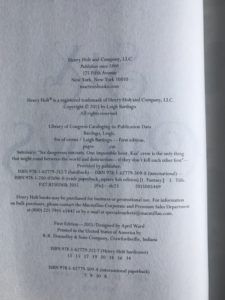
On this page, y'all can see the 2015 copyright date, and below where it says "first edition" afterwards the title. Look lower, and you'll meet that the impress run numbers aren't sequential, but they alternate on the left and right sides. This is a blueprint option, and varies past publisher. Since thirteen is the everyman number, that means my copy is from the 13th print run. Beneath you'll see a print run number from the international paperback edition—my copy is a hardcover, then my best guess is that this page is identical to the paperback international edition copyright page! This publisher chose not to include the twelvemonth that it was printed.
How does this vary when you accept a paperback edition, or an international edition? Let's take a expect at the American paperback edition of Wildlife by Fiona Wood!
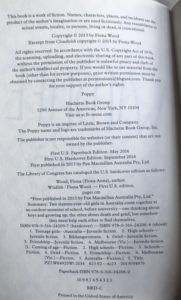
At the very top, you'll see that the copyright engagement is 2013. Even though the book didn't come out in the U.Due south. in 2013, that was the year copyright was outset filed. Expect a fiddling lower and yous'll come across that the first U.S. Paperback Edition came in 2016, and the start U.Due south. Hardcover Edition was published in 2014. Even lower, and the book says "First U.Due south. Edition." At the bottom of the page, you tin see that information technology is a first printing. Why does this all mean? It is the get-go edition, first printing of the paperback in the U.Due south. Considering so many versions of the book came before this re-create, it likely won't be worth a lot of money.
Occasionally, you'll see print run numbers that range 0–9, like this paperback copy of Shirley Jackson: A Rather Haunted Life by Ruth Franklin:
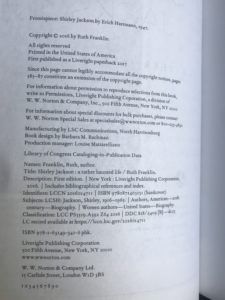
Notation that on this copyright folio, the print run numbers announced as " ane 2 3 4 5 half-dozen 7 8 9 0″; technically 0 is lower than 1, but what it refers to here is print run number 10! If the book is reprinted that many times (which could accept a while) the publisher will likely reformat these print run numbers to go higher—similar how the impress run numbers look on Six of Crows, above.
Sometimes, when you get a paperback re-create, it's not e'er obvious that this is a paperback following a hardcover release! See this copyright page for Trouble is a Friend of Mine past Stephanie Tromly.
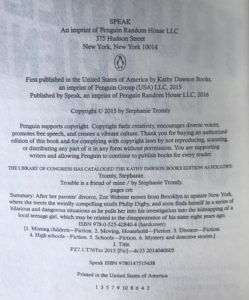
At the top, it says it's published past SPEAK (Penguin Group's YA paperback imprint). And so, information technology says "Showtime published in the United states of america of America by Kathy Dawson Books…2015," followed by "Published by SPEAK, 2016." The copyright is 2015. Y'all tin deduce and then that the latest copyright date for the format is the right ane for the book in your hands. Look farther downwards, and you tin see that it's a first print run of the first paperback edition!
Because of the variations between how publishers convey this information, it can be confusing! The print run system was introduced around the time of WWII, so any books published prior to the 1940s won't accept these hints—you lot'll take to do even more research to determine their edition based on publishers and their individual practices (many of which have now gone out of concern or been absorbed past bigger houses), or consult a rare book dealer.
How To Tell If a Book is Valuable
Outset off, the value of a volume ofttimes boils downwardly to simple capitalism—if people desire it, and there aren't many available, then it volition increase in value. The older the book and the harder information technology is to detect, the more than valuable it may exist. The more someone is willing to pay for a copy, the higher the price for other copies in the aforementioned print run.
If a book's initial print run is very small, and the book turned out to be a huge success later on, first editions may be more valuable. However, if you ain a re-create of The Little House on the Prairie from the 1950s, but information technology'southward a reprint edition, it doesn't matter that it's former and has the original cover fine art and is in pristine status—it probably won't be worth a lot because in that location are and then many copies in the world, and that particular championship has been a steady seller over many decades.
The value of a book may too be dependent on other factors, such as whether or not there were any printing errors in whatsoever of the print runs. Every bit weird equally it may sound, printing errors brand for valuable books! And sometimes signed early editions are pretty valuable, even if they aren't first editions from the first press! If the book is very, very pop, 2nd editions or reprint editions may exist desirable to collectors who don't have the cash to fork over for first editions but still desire a piece of rare book history. It just all depends on the book!
If you are interested in buying or browsing rare books and first editions, head over to the Rare & Collectible Books department on the Abe Books site or bank check out Bauman Rare Books. Rebecca Romney is a rare book specialist with a lot of keen info on her site. Y'all can also learn more in Carter'southward ABC for Book Collectors andCollected Books: The Guide to Identification and Values.And to read a fascinating article near collecting books, their values, and women's place in the merchandise, read near The Rare Women in the Rare-Book Trade.
Source: https://bookriot.com/first-edition/
0 Response to "How to Tell What Edition a Book Is"
Post a Comment